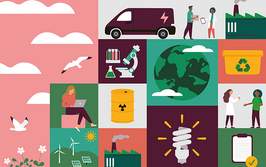Rising Above the Helium Shortage
Worldwide helium demand far exceeds current production levels. For many gas chromatography applications, the switch to hydrogen is painless. What’s stopping you?
Ed Connor |
Since the 1950s, helium’s inert nature has made it the go-to carrier gas for the majority of gas chromatography (GC) applications. Despite GC’s relatively low consumption of helium – estimated at less than two percent of the worldwide total (1) – laboratories now struggle to find a guaranteed supply and face stark price rises caused by worldwide refinery equipment failure and shutdowns (2), with scheduled maintenance of natural gas refineries causing further disruptions. The impact is compounded by increasing demand for helium from newly industrialized nations, such as China.
Helium, nitrogen, hydrogen, argon, and air can all be used as GC carrier gases – selection is mainly determined by the type of detector used. In some cases, helium can be substituted by hydrogen or nitrogen, both of which are readily available and relatively cheap. So why have they not been widely used as alternatives to helium until now? The short answer is that, in the past, there was no market pressure forcing chromatographers to adapt.
That has all changed. Now, GC manufacturers have started addressing the helium shortage in earnest. Bruker has released its Scion GC-MS systems specifically designed for use with hydrogen; Thermo has tested all of its GC products for hydrogen compatibility and has been highly pro-active in addressing the conversion of its GC systems to hydrogen through webinars and seminars, even producing a toolkit to assist customers in method conversion; and Agilent, with the largest GC market share, has hosted webinars, produced a carrier gas flow calculator app, and developed gas saving solutions to reduce helium consumption for applications that can’t use an alternative carrier gas source.
Anyone considering a move away from helium will have encountered the van Deemter curve, which shows the relative carrier efficiencies of nitrogen, hydrogen and helium. What this curve tells us is that nitrogen can perform better than helium and hydrogen, but only at very low velocities. Helium and hydrogen perform similarly at medium carrier gas velocities, with hydrogen actually outperforming once things really speed up.
The performance of hydrogen at higher carrier velocities provides clear advantages to those labs looking to increase sample throughput without compromising on sample quality (3). But one major issue facing labs using US Environmental Protection Agency (EPA) methods is that hydrogen is simply not an option in certain cases. Until these methods are approved for use with hydrogen, the hands of those analysts are tied.
Some chromatographers have raised concerns over the potential reactivity of hydrogen with analytes and chlorinated solvents, however, in their recent webinar on helium to hydrogen conversion, Thermo Scientific found no problem with MS spectra or identification of compounds (4).
There are also safety concerns from some quarters about the explosive nature of hydrogen, though many labs have been using hydrogen as the flame gas for GC with flame ionization detection (GC-FID) for years. Once hydrogen reaches 4% volume in air, it reaches its lower explosion limit (LEL; the upper explosion limit is 75%) and can undergo auto-ignition. However, being less viscous than helium, it more readily escapes. Unless a large quantity is suddenly released into the environment, the danger of reaching the LEL is relatively low. One alternative to hydrogen cylinders is a hydrogen generator, which produces the gas from de-ionised water. A hydrogen generator will typically contain less than a litre of gas at any one time, whilst being capable of supplying the requirements of a small lab.
For the foreseeable future, helium will be required for certain GC applications. However, as a finite resource, it will become more difficult to source with a resulting rise in price. Given hydrogen’s cost effectiveness and availability, coupled with the fact that it is the best ‘like-for-like’ alternative to helium, I believe it should become the carrier gas of choice in many GC applications.
- Mineral Commodity Summaries 2013 minerals.usgs.gov/minerals/pubs/mcs/2013/mcs2013.pdf
- articles.chicagotribune.com/2012-05-26/news/ct-talk-heliumshortage-0527-20120526_1_helium-shortage-balloon-algeria
- Thermo Scientific Application Brief 52360: “Moving from Helium to Hydrogen as a Carrier Gas for the Thermo Scientific ISQ GC-MS System”
- cen.acs.org/media/webinar/thermo_032113.html
Ed Connor joined Peak Scientific in February 2013 as GC/MS product specialist. Prior to joining Peak, Ed completed his Dr.Sc. at ETH Zurich in 2007 using GC-MS to look at herbivore induced plant volatiles and their interaction with beneficial insects. Ed then joined the University of Zurich where his work focussed primarily on floral volatile analysis using a variety of volatile collection methods, GC-MS and GC-FID. Ed is now working with Peak with particular focus on their GC product range. “I once heard that plants cry for help when they are damaged. Little did I know that I would later have the opportunity to work with GC as a tool to hear their chemical screams”

















